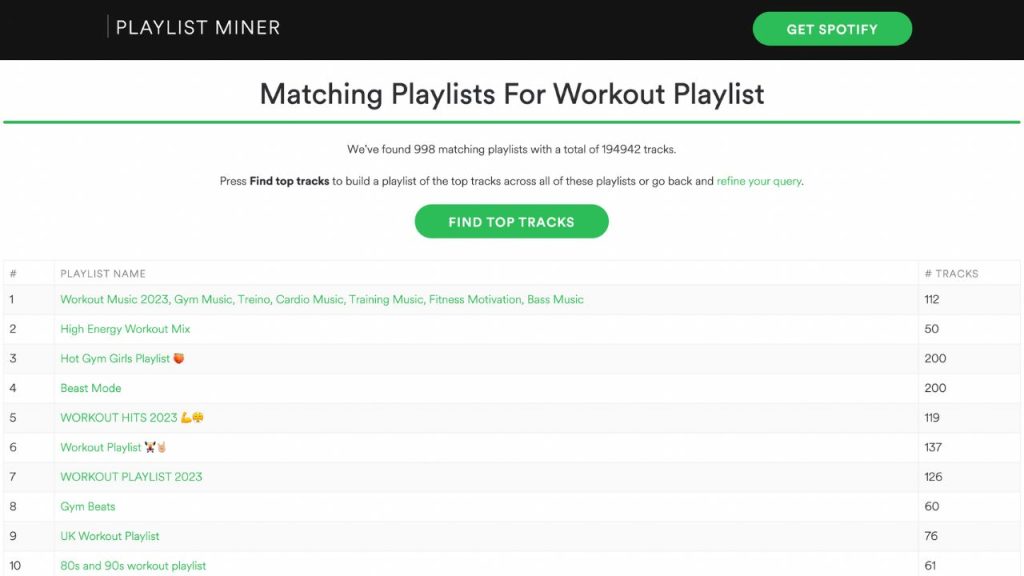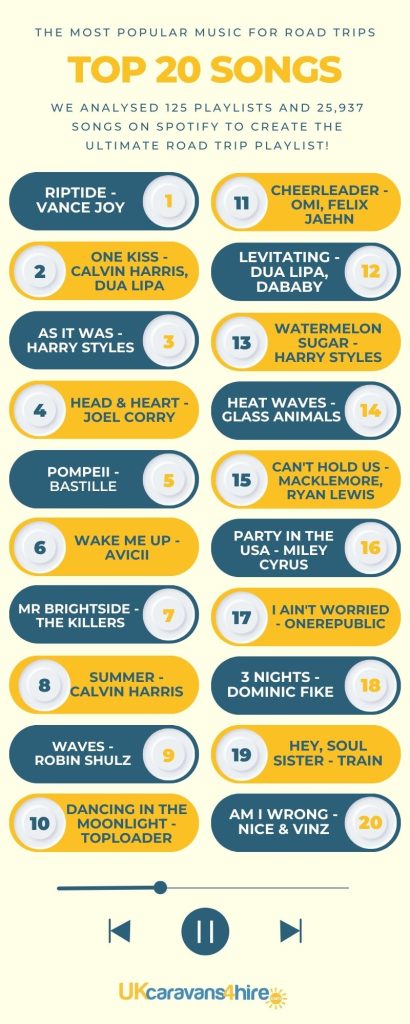Spotify is one of the most used music databases, providing hours of entertainment in songs, playlists, podcasts and even audiobooks.
Within the 100 million+ songs on the platform lies essential data about what users search for and how they organise their favourite songs, which can be incredibly useful for creating fun PR campaigns.
For example, we recently delved into Spotify data on behalf of ukcaravans4hire.com. We analysed which artists and songs Brits like to listen to when travelling in the UK to develop the ultimate road trip playlist for 2023. Spoiler alert: Taylor Swift, One Direction and the Glee Cast were the most popular artists across the playlists!
So, how can you use Spotify data to inform a digital PR campaign? Simply follow the steps below!
-
Keyword research
Any brilliant PR campaign begins with research into common search queries, and there are many free tools to help with this. Social listening tools such as Google Trends, Answer The Public, or Also Asked will help determine a newsworthy angle for your Spotify campaign.
Other keyword research tools, such as SE Ranking or SEMrush, help find relevant search terms for Spotify by showing the search volume (SV), cost-per-click (CPC), ranking changes over time, ranking difficulty and more!
For example, if you are looking for high-volume search terms related to a ‘beach playlist’ to discover the best songs for sunbathing on the beach, SERanking currently shows that the most searched terms are; ‘summer songs’ (8.1K monthly searches), ‘summer holiday songs’ (1.6K monthly searches) and ‘the beach soundtrack’ (1.3K monthly searches)¹.
-
Find top-ranking playlists for your keywords
Once you have decided on the key search terms relevant to your campaign, use these to analyse which songs, artists and playlists currently rank highest on Spotify.
To help, platforms like The Playlist Miner quickly find the top-ranking and most popular public playlists on Spotify that match your search criteria, along with information about how many tracks reside in the playlist.
For example, these are the results you would see for the search term ‘workout playlist’:

You can then collate the songs in these top-ranking playlists to find the most common song, artist or album.
-
Analyse the data to find a unique ranking
How you rank your Spotify data will depend on the campaign’s angle and objective. It is important to remember that you want to create a ‘unique’ ranking that journalists will be more likely to cover as it creates brand-new, newsworthy data.
For example, when we were looking into the ultimate road trip playlist, we first used Playlist Miner to see where each playlist ranked on Spotify’s search rankings for our five focus keywords (‘driving playlist’, ‘holiday playlist’, ‘road trip playlist’, ‘summer playlist’ and ‘travel playlist’.) Then, we gathered data on the number of playlist likes to help us determine the popularity of each one.
Once we had this data, we analysed the most popular songs and artists by determining how many times they appeared across all 125 playlists. This allowed us to calculate a top ranking and a playlist using the most popular songs for holidaymakers to enjoy.
You could look at other ranking metrics, such as the number of profile followers, number of songs or the length of the playlist.
Finding trends in these numbers will allow you to determine the most useful data to support your campaign. For instance, we revealed that Riptide by Vance Joy was the most popular song overall, and Taylor Swift was the most played artist for a summer road trip.

-
Build and optimise your own Spotify playlist
Spotify as a platform can also be used to raise brand awareness by showing your playlist to people searching for related queries. There are several tactics for Spotify search optimisation to improve your rankings amongst competing playlists.
Here are some top ideas to optimise your Spotify playlist:
Use a relevant, descriptive playlist title to match potential long-tail search queries that people are typing in
Use high-search volume keywords in your description, especially to describe the genre, theme or mood of your playlist
Include your company URL and a clear Call To Action in the description to draw users towards your website
Include a high-quality, relevant and branded image to stand out amongst other competing blogs
Creating your own playlist on Spotify will also encourage journalists to add a link back to your website and playlist from their article.
Here is a link to ukcaravan4hire.com’s ultimate road trip playlist for inspiration: https://open.spotify.com/playlist/7q8QdvhXadAsGUHBoCiTW3
-
Create engaging content
Once you have collated Spotify data to support your campaign based on your individual ranking metrics (playlist likes/rankings/length etc.), it’s time to create an engaging story surrounding this.
For example, last year, our team developed another campaign supported by Spotify data looking at the best songs to get a baby to sleep on behalf of eco-friendly nappy providers The Nappy Gurus, by analysing the most popular songs and artists featured in sleep-related playlists.
Bonus points if your story links into a trending topic or awareness day; we tied in our road trip campaign to World Music Day 2023 (check out our blog for inspiration on important upcoming days!)
Once you have created SEO-optimised supporting blog content and a press release, you should research the best contacts to send your release based on their interest in your client (or own) industry, interest in music and entertainment and their past and most recent articles.
By achieving linking coverage and backlinks in authoritative publications, you increase the chance of people listening to your playlist, remembering your brand, and even visiting your company website.
Other uses for Spotify data in marketing campaigns
Besides creating a data-led PR campaign, there are other ways that Spotify can be used to create engaging content.
Collaborative Playlists – Create an open, collaborative playlist which allows your audience to input songs that they feel resonate with your brand, which boosts brand awareness.
Influencer Partnerships – Engage with influencers or celebrities in your business niche by promoting a playlist created by them, using their fan base to draw more attention towards your products and services
How Wild PR can support your PR strategy
At Wild PR, we can assist with creating a strategic SEO-driven PR strategy for your business, overseeing the content creation and gaining additional backlinks to support your search rankings.
If you’re looking for creative ideas for your next digital PR campaign, get in touch today! In the meantime, you can check out our recent client campaigns here.
Sources:
- SEranking data correct as of June 2023